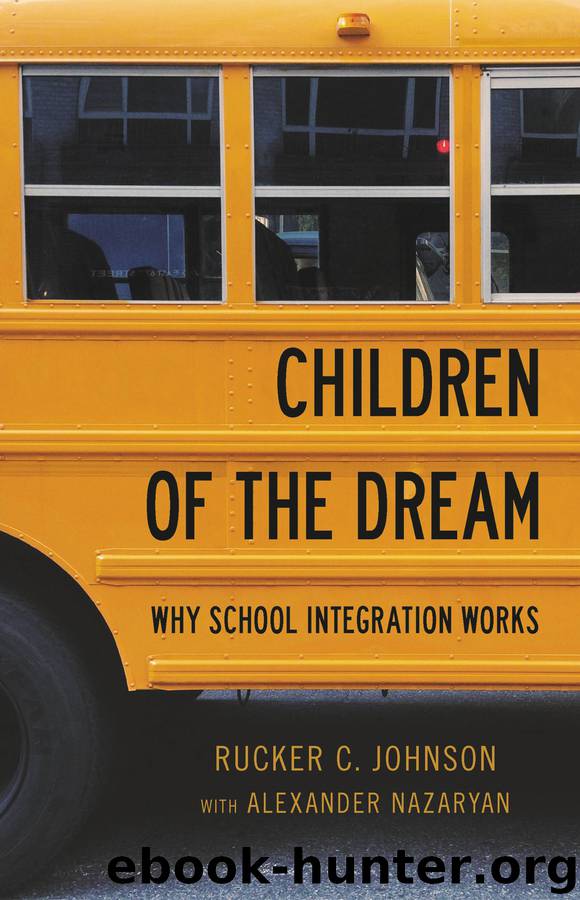Children of the Dream by Rucker C. Johnson

Author:Rucker C. Johnson
Language: eng
Format: epub
Publisher: Basic Books
Published: 2019-03-25T16:00:00+00:00
BUSING BEGAN IN Charlotte on September 9, 1970, the first day of the new school year. Attendance that first day was about 80 percent, much higher than it would be on the equivalent first day of integration in Boston. There were, however, some protests, which were staged by the Concerned Parents Association. As the New York Times would report, the association “told nearly 6,000 white parents that it was their patriotic as well as their strategic duty to peacefully disrupt the busing plan by keeping their children home.”11
More promising to the opponents of integration than a protest was the 1970 appeal of McMillan’s ruling to the Supreme Court, which at the time had four justices who had been appointed by Republican president Richard Nixon. While the Warren Court of the late 1960s had been led by a justice whom many considered a liberal activist, the Burger Court—so named for Chief Justice Warren Burger—signaled a kind of conservative return that has continued to this day.
The ruling in Brown v. Board of Education had been unanimous, reflecting an increasing national discomfort with the separate-but-equal doctrine prevalent in the Jim Crow South. It had been informed by social science research suggesting the deep psychological harm of segregation on the developing mind. By the time Swann arrived at the Supreme Court, the nation had changed considerably in terms of race relations, and not exactly for the better.
The nonviolent protests of the early 1960s had given way to the images of armed Black Panthers confronting police officers on the streets of Oakland and even in the California statehouse in Sacramento. There were riots in Newark and Detroit, as well as assassinations of police officers in Manhattan. The neighborhood of Watts burned in Los Angeles in 1965. By 1968, 95 percent of American households had a television set, and the continuing conflicts on the streets played out nightly on the screens in America’s living rooms. That spring, the nation watched as Chicago exploded in fiery civil unrest upon the news that Dr. Martin Luther King Jr. had been assassinated in Memphis.
For many white Americans, these images led to a dour and unpleasant conclusion: something had gone horribly wrong in the civil rights movement. The people looting stores and setting fires could not be the disciples of Martin Luther King, or even, for that matter, the more confrontational Malcolm X. Now, there was a raw anger nothing like the locked-arm unity of Selma. Many whites, watching the tumult of the late 1960s, had concluded that their earlier fears and prejudices were now being horrifically confirmed. If they had not fled the cities for the suburbs in the 1950s, they certainly did so now. Otherwise, they clustered in heavily ethnic enclaves—South Boston, Staten Island, parts of the San Fernando Valley—that seemed immune to “intrusion” by people of color.
Busing, especially in a district that represented a mix of both city and suburb like Charlotte-Mecklenburg, suggested a pulling-back of whites into the roiling city core they had sought to escape.
Download
This site does not store any files on its server. We only index and link to content provided by other sites. Please contact the content providers to delete copyright contents if any and email us, we'll remove relevant links or contents immediately.
The Secret History by Donna Tartt(18840)
The Social Justice Warrior Handbook by Lisa De Pasquale(12141)
Thirteen Reasons Why by Jay Asher(8791)
This Is How You Lose Her by Junot Diaz(6778)
Weapons of Math Destruction by Cathy O'Neil(6139)
Zero to One by Peter Thiel(5684)
Beartown by Fredrik Backman(5594)
The Myth of the Strong Leader by Archie Brown(5421)
The Fire Next Time by James Baldwin(5246)
How Democracies Die by Steven Levitsky & Daniel Ziblatt(5127)
Promise Me, Dad by Joe Biden(5087)
Stone's Rules by Roger Stone(5026)
100 Deadly Skills by Clint Emerson(4840)
A Higher Loyalty: Truth, Lies, and Leadership by James Comey(4840)
Rise and Kill First by Ronen Bergman(4701)
Secrecy World by Jake Bernstein(4640)
The David Icke Guide to the Global Conspiracy (and how to end it) by David Icke(4624)
The Farm by Tom Rob Smith(4434)
The Doomsday Machine by Daniel Ellsberg(4415)
